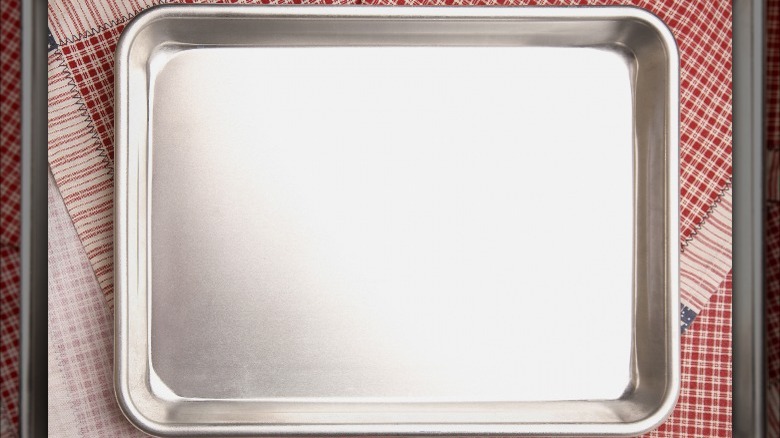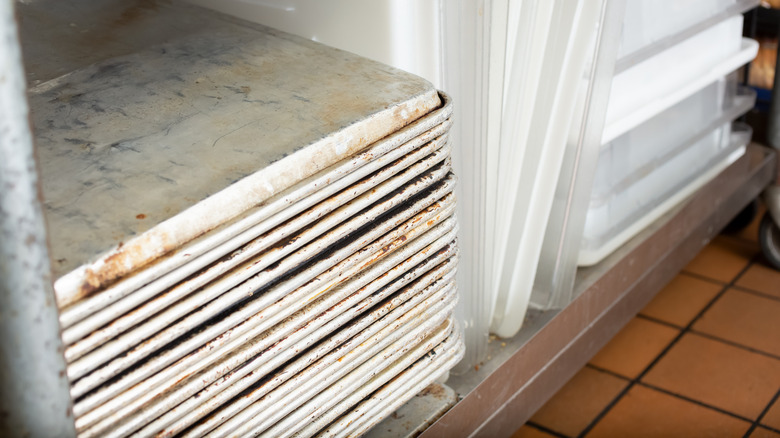The Kitchen Tool Ina Garten Can't Have Just One Of
There's no doubt that Ina Garten's beautiful kitchen is well stocked, but when it comes to sheet pans, the Barefoot Contessa has more than the average home cook, and for a good reason. While most kitchens have one or two, according to House Beautiful, Garten keeps a stack of eight half-sheet pans to bake everything from cookies, cakes, and brownies to roasting chicken and root vegetables.
While it may seem excessive, sheet pans have so many purposes in and out of the oven, and having a stack allows cooks to prep recipes, bake, roast, and serve without having to wait for a clean one. Owning so many sheet pans allows Garten to split ingredients, like potatoes, on two pans — giving the veggies more surface area to crisp in the oven, an important tip when roasting anything.
As food cooks, it releases moisture creating steam. If the pan is overcrowded (just like in a skillet), the food will steam cook and get soggy instead of roast, preventing the Maillard reaction, which is responsible for crisping and browning everything from bread to steaks.
Difference between sheet pans and cookie sheets
While you can bake cookies on a sheet pan, if you've ever tried to roast something on a cookie sheet, you know there's a fundamental difference between the two pans — the sides. Often referred to interchangeably, sheet pans have a one-inch rim on all four sides, while cookie sheets are flat with one or two raised, slanted sides.
Rimless cookie sheets are more one-trick ponies engineered solely to bake cookies. Their flat design allows hot air to circulate freely to bake cookies faster and evenly and lets bakers easily remove the cookies to a cooling rack with a spatula. They are often insulated to prevent cookie bottoms from burning and can be non-stick.
Sheet pans are more versatile. Although their low rim still allows air to circulate for browning and quicker cooking, the lip prevents food from rolling off and juices from spilling as it's transported in and out of the oven. Since they are not insulated, the food in contact with the hot pan browns faster.
Extra sheet pans are helpful when entertaining. They can be used as serving trays or filled with ice to keep perishable dishes like shrimp cocktail cold while the rimmed sides keep water from leaking as the ice melts. Add a cooling rack to the top and use the sheet pan to catch grease dripping from crispy fried food. This prevents the food from reabsorbing the extra grease and turning soggy.
What to look for in high quality sheet pans
Sheet pans are available in five sizes, from the largest one, full-size (18" x 26"), used primarily in professional kitchens, to a ⅛ size sheet pans (6 1/2" x 9 1/2"), small enough to fit into a toaster oven. The most common size, the half-sheet pan (13" x 18"), allows home cooks to place two side by side on a single oven rack to maximize space.
When purchasing a sheet pan, look for a sturdy one made of 10 to 18-gauge aluminized steel or uncoated aluminum. Heavy gauged sheet pans cook food more evenly and resist warping, a common issue with thinner models. Although a nonstick surface releases food quickly and is a breeze to clean up, an uncoated surface is more versatile. It can withstand hotter temperatures, which is ideal for roasting a chicken or making pizza. The uncoated surface can still be covered in parchment paper when baking cookies but scrubbed clean after each use. It has a longer lifespan than nonstick pans, which should be replaced when chipped.
Uncoated sheet pans are available with a matte or shiny finish. Over time, matte camouflages wear better; however, the finish won't affect its quality and is a matter of preference and aesthetics. Cheap pans that are warped and dented shouldn't be used. They won't cook food evenly, resulting in burnt bottoms and undercooked tops even if the oven temperature is accurate.



